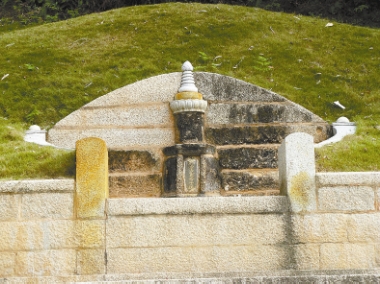 The Tomb of Huang Motang James Baquet IN recent weeks we’ve visited the Huang family museum in Xiasha Village and the Huang Ancestral Hall in Shang Meilin. These are both connected to one figure, Huang Motang, whose descendants settled both in these villages and several others. Said to be a 14th-generation descendant of patriarch Huang Qiaoshan, a native of Fujian in the Song Dynasty with 21 sons, Huang Motang died more than seven centuries ago. His tomb dates to 1248 and was rediscovered in 1991. Entering Lianhua Hill Park from the northwest gate (across from Beijing University Shenzhen Hospital), cross a plaza to the right with trees in boxed planters and enter the forested area to the south. There you’ll see a classic Chinese gate in the style known as paifang, with four columns in a straight line and three panels high up between them. This kind of unpainted stone paifang is reserved for religious areas and burial grounds. Around the gate are tablets inscribed with Huang family information (all in Chinese). Inside the gateway is a D-shaped pond (essential to the site’s feng shui), with stairs leading around either side toward the tomb itself. It’s an exquisite small stone “pagoda,” about half a meter wide and one-and-a-quarter tall, with Huang’s name carved in granite. It is surrounded by a rather elaborate, modern setting of cut block, but the pagoda itself is ancient. It’s worth a quick visit. If you have time, climb to the top of the mountain for a view of the city built by Huang’s descendants and millions of others. Notice: James Baquet will be leading free “Culture and History Walks” in Shenzhen on Saturday mornings in October and November. Write to him for more information: jamesbaquet@gmail.com | 
